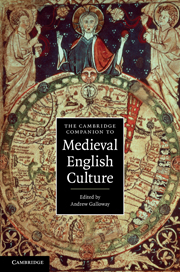Book contents
- Frontmatter
- Introduction
- Part one Theaters of culture: political, legal, material
- Part two Cultural ideals and cultural conflicts
- Part Three Literacies, languages, and literatures
- 7 Visual texts in post-Conquest England
- 8 Literacy, schooling, universities
- 9 Anglo-Latin literature in the later Middle Ages
- 10 The vernaculars of medieval England, 1170-1350
- 11 English literary voices, 1350-1500
- Part four Legacies and re-creations
- Guides to further reading
- Index
8 - Literacy, schooling, universities
from Part Three - Literacies, languages, and literatures
Published online by Cambridge University Press: 28 July 2011
- Frontmatter
- Introduction
- Part one Theaters of culture: political, legal, material
- Part two Cultural ideals and cultural conflicts
- Part Three Literacies, languages, and literatures
- 7 Visual texts in post-Conquest England
- 8 Literacy, schooling, universities
- 9 Anglo-Latin literature in the later Middle Ages
- 10 The vernaculars of medieval England, 1170-1350
- 11 English literary voices, 1350-1500
- Part four Legacies and re-creations
- Guides to further reading
- Index
Summary
Medieval literacies
Education and its delivery reflect the most salient aspirations of any culture. Teaching is the basic form of traditio, the “handing on” of values deemed culturally central. In its product, the educated person of whatever level of attainment, it has replicated not only those values useful socially but also provided the tools deemed necessary for perpetuation of that cultural system. This chapter will seek to examine some features of this process in England in the later medieval period, from about 1200 to the early sixteenth century.
Although there remains a common perception of massive illiteracy (generally exaggerated: it was perhaps higher in the early Modern period), medieval culture was considerably more “literary” than even the modern world of a half century ago. Everywhere in Europe, the centrality of literate behaviors to culture was insured by the conversion to Christianity, an event that occurred in Anglo-Saxon England from about 600. The centrality of the sacred text, the general propagation of its narrative and basic ideas, and the liturgical ceremonial that enacts its precepts all required books and the literate tools to use them. Such a mandate always provided an impulse for and one focus of English schooling.
- Type
- Chapter
- Information
- The Cambridge Companion to Medieval English Culture , pp. 172 - 194Publisher: Cambridge University PressPrint publication year: 2011
- 2
- Cited by



